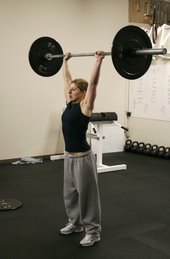The study was done in Finland where apparently they aren't afraid to get sued by a bunch of 30-somethings with ankle sprains and various maladies to whine about. They peeled them right off the coach and made them jump. That's beautiful. And if the following statement doesn't make you cry, you're just dead inside:
"With increasing age, the capacity to produce explosive muscle force declines more dramatically than maximal muscle strength. To maintain functional capacity, strength training and power-type strength training are recommended for middle aged and elderly people."
Notice that they didn't say, "With increasing age, the capacity to produce explosive muscle force declines more dramatically then maximal muscle strength. So, give it up, take up mall walking buy a chair to haul your butt up the stairs to your Craftmatic adjustable bed and start making excuses for why you can't, won't and don't."
"The injury rate in this study was low (19% in men and 6% in women). For comparison, injury rates ranging from 24% to 40% have been reported among middle aged male and female runners; knee injuries were the most common. Correspondingly, the injury rate was 12% for middle aged sedentary male and female participants in a supervised one year worksite exercise programme."
Injury is a convenient excuse used by a trainer who can't coach explosive movements and don't have a clue about the proper progression. The finger wagging injury conversation is the easiest way for a lazy trainer to get paid the same per hour without adding any additional tools to his/her skill set. I know that I honestly would never have figured out Coach Bergener's snatch progression on my own but because he poured his wisdom into that little piece of genius, I'm able to teach my clients. First, though, I had to put in the time to learn it.
"Despite the high amount of jump and sprint exercises in the training programme, knee symptoms did not show any significant increase compared with the non-exercising control group, which certainly contributed to the increase in self rated health and fitness among participants. However, old knee troubles recurred in male participants who had previously practised various kinds of sports that stress the knees, such as ball games. High BMI may also have increased the risk of knee disorders. Knee symptoms, especially knee pain itself without any exercise involved, are associated with poor perceived health and increased mental distress. In this study, the interruptions in training were short, indicating that the disorders and injuries were not serious."
I went to Dr. Rowe, my family physician, when I was a freshman in college. I had recurring knee pain that he once diagnosed as 'growing pains.' Given that I was the same 5 feet, 4 inches since the age of fourteen, something wasn't right. At this point, given all the aching, I should have been over ten feet tall. He poked, he prodded and he then looked at my philosophically, "sometimes things just hurt," he said. My insurance paid for the visit.
I had a friend who gave me place mats made in Zimbabwe - worst mass production ever. None of them were the same size and all the seems were crooked. Our bodies are like products from Zimbabwe - sometimes it's not the best craftsmanship. I remember watching 'Mini Med School' on PBS and the doctor was saying that one of the most vexing parts of spinal surgery is that everything looks completely different when you open someone up. Given that, it's no surprise that we have aches and pains and things that hurt. Sometimes we work through them and sometimes we work around them. It isn't a good reason to quit.
Feasibility of power-type strength training for middle aged men and women: self perception, musculoskeletal symptoms, and injury rates.
Surakka J, Aunola S, Nordblad T, Karppi SL, Alanen E.
Social Insurance Institution, Research and Development Centre, Turku, Finland. jukka.surakka@kela.memonet.fi
OBJECTIVES: To examine the feasibility of a power-type strength training programme for middle aged men and women, the impact of the training programme on perceived health and fitness and on knee and low back symptoms, and the rate of exercise induced injuries.
METHODS: A total of 154 voluntary, healthy, sedentary men and women participated in a training programme lasting about four months. The explosive force of leg extensor muscles was measured by means of standing long jumps and vertical squat jumps. Perceived health, perceived fitness, and low back and knee symptoms were assessed before and after the intervention by using a questionnaire. Musculoskeletal disorders and exercise induced injuries were reported during the training programme.
RESULTS: Perceived fitness improved in both men (p<0.01) and women (p<0.0001), but perceived health only in women (p<0.01). Men with increased explosive force in squat jumping also showed better perceived health (p<0.05), and women with increased explosive force in standing long jump showed better perceived fitness (p<0.05). Exercising men who had increased knee symptoms had significantly higher body mass index than the other exercising men (p<0.05). The exercise induced injury rate was 19% in men and 6% in women.
CONCLUSIONS: Successful completion of the exercise programme, together with the increased physical activity and relatively low injury rate, may have contributed to the participants finding the exercise programme positive and stimulating and believing that their health and fitness had improved. The low rate of musculoskeletal injury suggests that this type of supervised exercise programme is feasible for untrained middle aged people.
Br J Sports Med 2003;37:131-136© 2003 BMJ Publishing Group & British Association of Sport and Exercise Medicine






